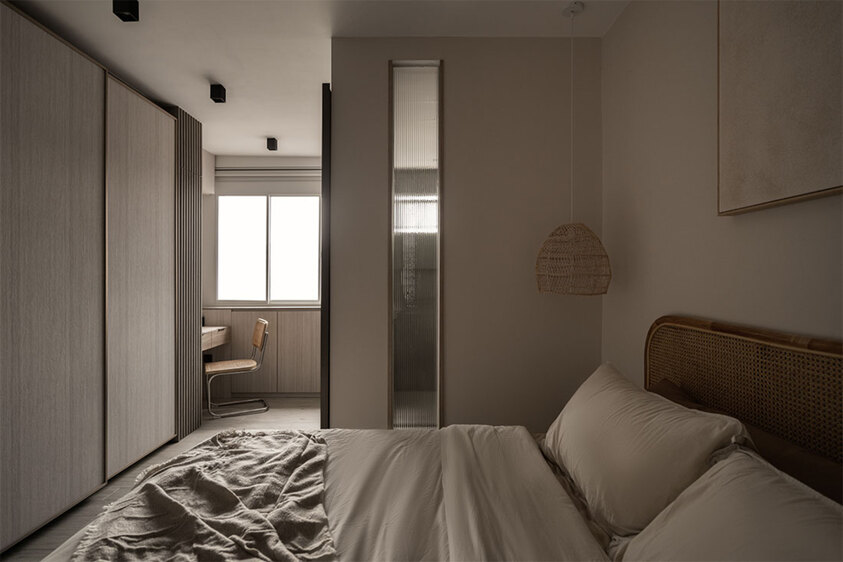At the Bedroom

Source: HOFT Interior
In the serene embrace of the wabi-sabi bedroom, the first light of dawn gracefully filters through the window, casting a soft, golden glow onto the dresser table and the rattan chair nestled nearby. The imperfections and weathered charm of the room come alive under the gentle morning light.
The dresser table, adorned with simple, well-loved trinkets, seems to embrace the essence of wabi-sabi - its wooden surface bearing the marks of time and use. A delicate vase holds a few wildflowers, their imperfect beauty perfectly complementing the room's aesthetic.
Adjacent to the dresser, a light oak sliding wardrobe stands, its minimalist design resonating with the room's aesthetic. Its smooth panels, softened by the morning light, quietly beckon to the day ahead.
The wooden rattan bed head, with its intricate design, forms a striking focal point. Draped in plush bedding and pillows, it invites a peaceful night's rest and a morning of quiet reflection. Above the bed, a rattan decor light fixture hangs, casting intriguing shadows on the walls, adding to the room's charm.
On the opposite wall, a large textured art piece, an exquisite testament to imperfection, hangs gracefully. Its muted colours and tactile surface draw the eye and encourage contemplation.
Beside the bed, a sleek design acrylic panel adds a touch of modernity to this otherwise rustic space. Its transparency creates an interesting interplay of elements, allowing the room's natural beauty to shine through in unexpected ways.
The wabi-sabi bedroom is a sanctuary where the morning light and the worn, imperfect beauty of the furnishings come together, creating a space that is both tranquil and endlessly fascinating. Each glance reveals new details, inviting you to appreciate the artistry of life's fleeting moments.
Those who prefer a minimalist lifestyle will appreciate the simplicity inherent in wabi-sabi design. The focus on uncluttered spaces and a limited colour palette can appeal to individuals who value simplicity and tranquility in their homes. Wabi-sabi's emphasis on natural and sustainable materials aligns with eco-conscious values. Homeowners concerned about the environmental impact of their choices may opt for this theme.
To achieve this Wabi Sabi theme, you will need to:
- Natural Materials: Use natural materials like wood, stone, rattan, and linen. These materials should be chosen for their organic textures and inherent imperfections.
- Minimalism: Keep the decor simple and uncluttered. Less is more in wabi-sabi design. Choose only items that are meaningful and essential to your space.
- Imperfection: Celebrate imperfections in furniture and objects. Items with signs of wear, age, or weathering are valued for their character and history.
- Neutral Colour Palette: Opt for a subdued and neutral colour palette that reflects the simplicity and serenity of nature. Colours should be muted and earthy, such as soft greys, muted greens, and warm browns.
- Handmade and Artisanal: Incorporate handmade and artisanal items. These can include pottery, ceramics, and textiles crafted by skilled artisans, each bearing unique marks.
- Natural Light: Maximise natural light in your space. Allow sunlight to highlight the imperfections and textures of your furnishings.
- Indoor Plants: Bring the outdoors in with the addition of indoor plants. Their living presence adds vitality and a connection to nature.
- Texture and Layering: Layer textures in your decor. Mix rough and smooth textures, such as a polished stone countertop with a weathered wooden table.
- Functional Items: Choose functional items that serve a purpose in your daily life. Each item should have utility and significance.
- Personal Touch: Add personal touches and items that have sentimental value. These can be family heirlooms or objects that hold special memories.
Avoid:
- Excessiveness: Avoid excessive ornamentation and decoration. Keep the space uncluttered and free from unnecessary embellishments.
- Perfectionism: Resist the urge to seek perfection in design. Embrace the natural flaws and quirks of objects and materials.
- Synthetic Materials: Minimise the use of synthetic or overly processed materials. Instead, prioritise natural, sustainable options.
- Harsh Lighting: Avoid harsh, artificial lighting. Opt for soft, diffused lighting that enhances the warmth and character of your furnishings.
- Overly Matchy-Matchy: Avoid overly coordinating or matching furniture and decor. Embrace a mix of styles and pieces that tell a story.
- Rigid Symmetry: Wabi-sabi design often eschews strict symmetry. Embrace asymmetry and irregularity in your arrangements.
- Excessive Technology: While technology has its place, minimise its visual impact. Hide cords and gadgets, when possible, to maintain a serene atmosphere.
- Impersonal Decor: Steer clear of mass-produced, generic decor items. Instead, opt for items that have a personal connection or a story to tell.